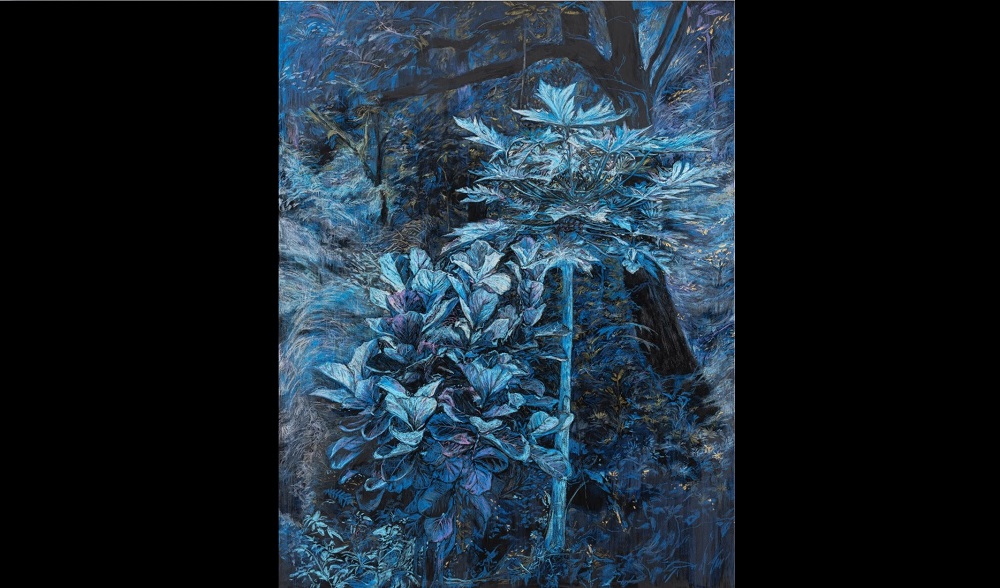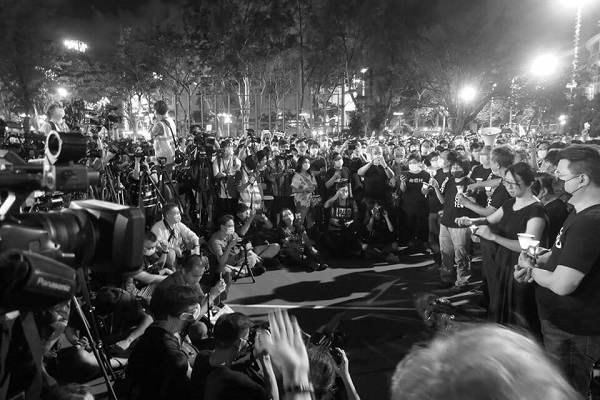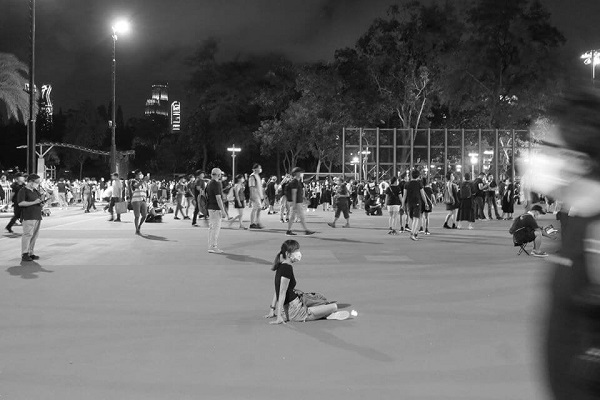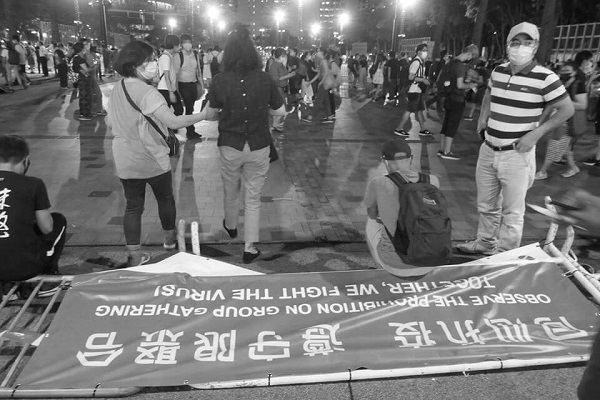Art Issues
- Art and JusticeThe latest article on a special issue topic is below. Other articles on the same topic can be read by clicking on the 'Archive' year and month on the side-bar.
繪畫/現在 | Painting Now
John BATTEN
at 4:21pm on 29th June 2020





圖片說明:
1. 簡喬倩:《Awake 3》,2019年,畫布油彩, 180×140厘米(圖像由藝術家提供)
2.-5. 2020年6月4日,香港,維多利亞公園:雖然警方以2019新冠病毒下的限聚令為由而未有就本年的燭光晚會發出不反對通知書,人們依然聚集悼念天安門事件(照片由作者提供)
Captions:
1. Tobe Kan Kiu Sin: Awake 3, 2019, oil pastel on canvas, 180x140cm (Image courtesy of the artist).
2.-5. People gathered to remember the Tiananmen massacre, despite an official police ban using Covid-19 social gathering restrictions on this year’s candlelight vigil, Victoria Park, Causeway Bay, Hong Kong, 4 June 2020 (Photos: John Batten)
(Please scroll down for English version)
我這陣子在不停播放蘇格蘭樂隊Arab Strap的歌。他們的音樂就是上星期重要時刻的原聲帶。樂隊以原始的蘇格蘭方言演唱,歌詞令人想起淒慘的風景,還有離離合合的關係,還有令人難以信服,來自濫藥、酗酒、意外的吻或性的愉悅。你讀著本文時,最好可以同時聽聽Arab Strap的作品,包括《The First Big Weekend》、 《Girls of Summer》或者是《The Shy Retirer》,又或任何他們的歌或專輯。
我近日和很多藝術家見面,有時候在他們的工作室。我希望在2019新冠病毒被迫活動停擺的這段時間再次和他們聯絡,看看藝壇都在發生什麼事,也看看個別藝術家的近況。我通常一邊和他們聊天,一邊看作品,是輕鬆的會面,希望藝術家也這麼認為。幾星期前,我在香港藝術中心的聯展上看過簡喬倩的新畫作,我想拜訪她然後寫寫關於她的文章。簡氏自2018年在香港藝術學院畢業後,便一直努力建立個人風格和提升技藝。雖然她最近已舉辦了個人展覽,也參加過不少聯展,但至今還沒有人為她撰文。這是香港常見的情況:只有幾份報章、幾個網站和幾份雜誌以藝術為專題,然後千篇一律地只出現為人熟悉的藝術家名字,很少會看到近年畢業的人或新晉藝術家。所以,除了友善交談,我需要做好準備,熟識一下簡氏此前的作品,然後配對出一些問題來。這樣可以幫助我們保持交談的焦點。我們最終選了在一個星期天的下午,在簡氏藝術家朋友暫借她的柴灣工作室見了面。
然後我坐下來,要寫一篇1,500字的文章,介紹簡喬倩和她的作品。我坐著,坐著,打了幾個字,但更多時間仍是聽著Arab Strap。
過去三星期還有很多令我分心的事情。我在讀韓國女作家韓江的小說《少年來了》(2014),她以虛構的驚人故事說出了1980年5月18至27日期間在南韓發生的光州事件,當時未經民主選出的全斗煥軍事政府殺死了數百爭取民主示威者,全斗煥現年89歲,仍然在世而且沒有被監禁。屠城事件40年周年暨紀念事件的藝術雙年展,因為今年的疫情而被取消。另一方面,也有事件的餘波越演越烈。2020年5月25日,非裔黑人弗洛伊德在美國明尼阿波利斯被警察跪頸,期間曾懇求警察饒了他,並說道:「我無法呼吸」。他後來窒息身亡,事件觸發了美國全國和世界多個大城市的連場示威。這些示威呼應了香港2019至2020年時所經歷的反政府示威,雖然我城的示威與美國系統性種族主義和種族劃線無關,但公眾人士對警方採取的策略同樣憤怒,包括他們過激的束縛方法,還有國際特赦組研究所指出,在密閉空間使用危害生命的催淚氣體。

2020年6月4日,香港,維多利亞公園:雖然警方以2019新冠病毒下的限聚令為由而未有就本年的燭光晚會發出不反對通知書,人們依然聚集悼念天安門事件(照片由作者提供)
然後,在公眾憂慮內地即將頒佈的國家安全法之際,香港每年在維多利亞公園舉行,為紀念1989年6月4日天安門事件受害人的燭光紀念晚會沒有獲得警方批准,表面上是因為疫情下的限聚令,但也可能是上年反政府示威仍然持續下的政治考慮。儘管如此,數以千計的市民安靜地來到維園悼念受害人。然而,足球場上卻有著兩組非常不同的群組:支聯會的何俊仁和李卓仁領禱悼念逝者,也發表悼念講話。在公園的另一端,同樣多人的群組圍著獨立旗幟叫口號。諷刺的是,何、李二人和支聯會的其他成員其後因為非參與非法集結而被檢控。高舉港獨旗幟的人似乎沒有被警方以類似罪名控告。這種情況將令未來的六四燭光晚會進退兩難:市民和平出席,點起燭光悼念亡者的活動應該得到警方批准。然而,港獨活躍份子騎劫這項活動借機鼓吹獨立,在未來國家安全法下肯定是被禁止的行為,有可能破壞未來的六四晚會。
簡喬倩的最新畫作延續了叢樹和葉子的系列,刻劃了警方為了驅散街上示威者,以水炮車噴出加入胡椒噴霧的藍色水柱後留下的情況。這種藍水不但令人刺痛,而且會把所有碰到的東西變成藍色,不論是人、水泥街道、草還是樹都無一倖免,就像簡喬倩現在在她藍色作品中所繪畫的草木一樣。
我最後完成了一篇冷靜清醒的文章,說明簡喬倩和她筆下的精彩藝術,這篇文章將於本月稍後時間在藝術雜誌《藝源》中刊登。除了描述她藍色繪畫作品中與水炮車的關聯,我沒有討論香港的社會和政治情況,又或以上所列出的事件。然而,簡喬倩所繪畫的是現在的事,正如無數也在創作的藝術家一樣。我所寫的也是現在的事情,而未來的讀者或歷史學家都不可能忽視「現在」。創作背景和創作行為同樣重要;即使只是隱約可見,它也滲透在藝術家或作家的作品中。
我仍然聽著Arab Strap。然而,我可以提出一個不太重要的事實––這只是純粹的男性放縱,一種對曲詞的暫時入迷,有著想像中比真愛或性或政治更大的存在主義意義:「…But, when I feel like this, I know it doesn’t matter / When I eat when I’m not hungry I’m sure I feel my face get fatter / Then I thin out every weekend and I think that she might want me / But, I always slap off on my own ‘cause / I let those feelings haunt me, they control me….」(但,當我感到如此,我知道那沒有所謂/當我肚子不餓時進食,我肯定自己感到臉容也在長胖/然後我每個周末都在減肥,我以為她不再想要我/但,我常常因為自己的原因靜靜離開/我讓那些感覺迷或我,它們控制我……)*
*Arab Strap,《The Shy Retirer》,收錄在 專輯中,2003年。
簡喬倩網頁: https://t-o-b-e.weebly.com/
原文刊於《明報周刊》,2020年6月22日
Painting Now
by John Batten
I have been binge listening to Scottish band Arab Strap. Their music is the soundtrack to the last momentous weeks. Sung in a raw Scottish vernacular, the words evoke a dismal landscape and circular on-off relationships, and, unconvincing pleasure from popping pills, drinking, an unexpected kiss, or, sex. Ideally, while you are reading this, you could also listen to Arab Strap’s songs The First Big Weekend, Girls of Summer or The Shy Retirer – or, any of their songs or albums.
Recently, I have been meeting artists, sometimes in their studios. My motivation is to get back in touch, during this enforced Covid-19 lull in activities, with what is happening in the art scene and see what individual artists are doing. I usually chat and look at their work – a relaxed meeting, hopefully for the artist as well. A few weeks ago, after seeing her new paintings in a group exhibition at the Hong Kong Arts Centre, I wanted to visit and then write about artist Tobe Kan Kiu Sin. Since graduating from the Hong Kong Art School in 2018, she has worked hard to develop her own style and improve her technical skills. No-one has previously written about her, despite recently having had a solo exhibition and participation in numerous group shows. This is often the way in Hong Kong: only a few newspapers, online websites and even fewer magazines feature art, and then invariably it will be about familiar art names, not recent graduates and younger artists. So, rather than just amiable chatting, I needed to prepare and refamiliarize myself with Kan’s past work and map out questions. We can, then, have a focused chat. We did, one Sunday afternoon in her Chai Wan studio, temporarily lent to her by a kind artist friend.
Then I sat down to write a 1,500-word profile about Kan and her work. I sat, and sat, typing a few words, but I spent more time listening to Arab Strap.
There were other ‘distractions’ over the past three weeks. I was reading Korean writer Han Kang’s Human Acts (2014), her shocking fictional account of the Gwangju massacre in South Korea when the unelected military government of Chun Doo-hwan (who, at 89 years of age, is still alive and free) killed hundreds of protesters demonstrating for democracy between 18 to 27 May 1980. The fortieth anniversary of the massacre and the art biennial, that memorialises the massacre, were curtailed by Covid-19 restrictions this year. Still raging is the aftermath of African-American George Floyd’s death on 25 May 2020 in Minneapolis, USA after a policeman held his neck down with his knee as Floyd pleaded, “I can’t breathe.” His suffocation triggered protests across the USA and cities around the world. These protests echo, without the systemic racism and racial profiling of the USA, similar public outrage of policing tactics during anti-government protests in Hong Kong during 2019-2020, which includes aggressive restraint methods, and, as researched by Amnesty International, life-threatening use of tear gas in enclosed spaces.

People gathered to remember the Tiananmen massacre, despite an official police ban using Covid-19 social gathering restrictions on this year’s candlelight vigil, Victoria Park, Causeway Bay, Hong Kong, 4 June 2020 (Photo: John Batten)
Then, amidst public anxiety of the coming promulgation by the mainland of national security legislation, Hong Kong’s annual Victoria Park memorial candlelight vigil in memory of the victims of the Tiananmen massacre on 4 June 1989, was not given permission to be held by the police this year, ostensibly due to Covid-19 crowd distancing restrictions, but politics is probable, as the 2019 anti-government protests continue rumbling. Nevertheless, thousands peacefully came to Victoria Park to remember the victims. There were, however, two distinct groups on the football pitches: prayers and remembrance speeches to those who died were led by Albert Ho Chun-yan and Lee Cheuk-yan of the Hong Kong Alliance in Support of Patriotic Democratic Movements in China. At the other end of the park, an equally large crowd gathered around independence flags chanting slogans. Ironically, it was Ho and Lee and other members of the Alliance who were later informed they would be prosecuted for participating in an illegal assembly. The independence flag-wavers do not appear to have been similarly charged by the police. This could be a dilemma for future 4 June vigils: a peaceful turnout by the public to light candles and remember the dead should receive police permission. However, independence activists could jeopardize future 4 June vigils by high jacking the event to promote independence, certainly a proscribed activity under future national security laws.
In a continuation of a series of work depicting trees and foliage, Kan’s most recent paintings mirror the outcome of the blue-coloured pepper-infused water fired from water cannon trucks used by police to disburse Hong Kong street protesters. This blue-dyed water stings and stains everything it touches: people, concrete streets, grass and trees, including the trees that Kan depicts in her now-blue paintings.
I eventually finished writing a sober piece of explanatory text about Kan and her marvellous art, which will be published in Artomity art magazine later this month. Apart from the association with water cannons seen in her blue paintings, I did not discuss Hong Kong’s social and political events, or the incidents outlined above. However, Kan is painting right now, as are countless artists doing creative work. My writing is now and the ‘now’ can never be ignored by future readers or historians. The context for creativity is as important as the creative act; it is infused, even slightly, in an artist’s or writer’s work.
I am still listening to Arab Strap. However, I could argue, that is an insignificant fact – it is just pure male indulgence, a temporary obsession with music and lyrics that have, momentarily, an imagined greater existential meaning than real love or sex or politics: “…But, when I feel like this, I know it doesn’t matter / When I eat when I’m not hungry I’m sure I feel my face get fatter / Then I thin out every weekend and I think that she might want me / But, I always slap off on my own ‘cause / I let those feelings haunt me, they control me….”*
*Arab Strap, The Shy Retirer, on their album ‘Monday at the Hug and Pint’ (2003). The written lyrics read “…slip off…” (as in ‘leave quietly’), but are sung as “…slap off…” (to masturbate).
Tobe Kan Kiu Sin website: https://t-o-b-e.weebly.com/
Originally published in Ming Pao Weekly, 22 June 2020. Translated by Aulina Chan.
